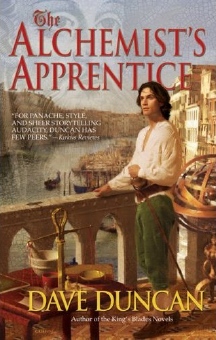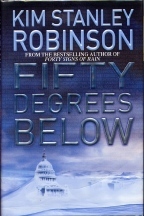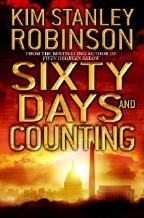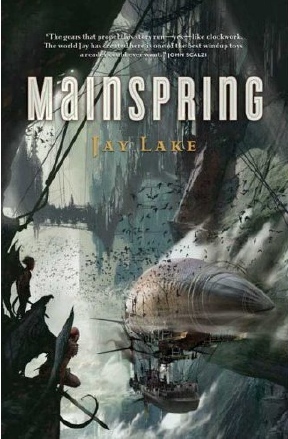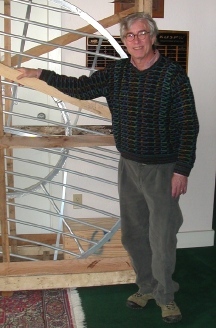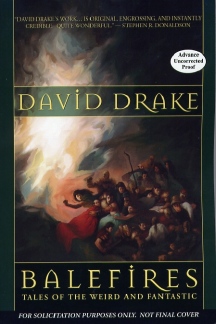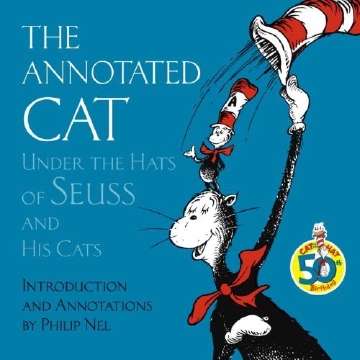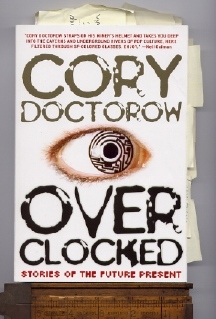Trashotron.com |
||
This Just In...News From The Agony Column
02-17-07: Where The Dust Settles
Preview for Podcast of Monday, February 19, 2007
Here's a link to an MP3 preview of Monday's Podcast. I am so so incredibly lucky to work with such people. I thank and salute them.
02-16-07: Dave Duncan Enlists 'The Alchemist's Apprentice' ; A Review of Kim Stanley Robinson's 'Sixty Days and Counting'
Skullduggery Not Smugduggery
Readers know that I treasure books in all their physical, papery glory. But I am sorely tempted to do Dave Duncan a favor and start a campaign to cover the covers of his new book 'The Alchemist's Apprentice' (Ace / Berkley / Penguin Putnam ; March 6, 2007 ; $14.00). Maybe someone will email me a better cover design for this book. I think that the art director looked on page one, wherein we find the novel begins on Valentine's Day, and said, "Let's make this look like a cheesy Harlequin Romance novel!" Yikes! Mission accomplished, folks! You've driven away about 90% of the potential customers for this novel.
The real shame is that this novel could easily have received a different, more effective but equally cheesy cover design, spun off from That Book. It does, after all, involve the shenanigans of Nostadamus, with conspiracies and whatnot. Yes, things get a bit silly, but on purpose, not by accident as in That Book. But this book looks like crash course in creative pouting. If you’re going for the cheese folks, at least get the right kind of cheese! THIS IS RIDICULOUS! I'm surprised that the dude on the cover isn’t holding a friggin rose. In his teeth.
So, why should Agony Column readers give a second glance at what looks to be a bad historical romance? Because it is nothing of the kind, but instead a crackin' good historical fantasy thriller with a bit of farce tossed in to keep things from getting too serious. Moreover, it doesn't require a lot of explanation to convey the appeal. In a historical Venice that is not the Venice of our history, Nostadamus is not just your average astrologer. (OK, astrology, Valentine's day ... I can see why someone who didn't read the book might think it was romance. But really. REALLY.) Nope, our favorite seer also messes about with alchemy, magic and even demonology. With a side of chicanery and obfuscation. And given that he doesn't see it coming, you can guess he's really good at the PR end and not so hot at the back-end tech, in this case, dealing with the results of dabbling in demonology. Obviously, they hadn't built up a horror movie industry back then or else he'd know what was coming.
Nostradamus gets his garters stuck in some nasty gearwork but at least has the foresight to know that what will come knocking at the door on a stormy night is not likely to be benevolent. He hies himself hence and leave his apprentice (read: stooge) to deal with the dirty work. Good for Nostradamus, not so good for Alfeo Zeno. Much better all around for readers.
This is rock 'em, sock 'em Renaissance skullduggery of the most compelling variety. Monsters, swords and murder make things tough for our young tough, but he's a pip, this one. A pip for the readers, whose minds will ratchet back into slack-jawed, droolworthy enjoyment while mysteries unfold, some solvable, some not so amenable to solution. Scams and the supernatural. And lots of solvents to boot. This is the Renaissance, and Venice was a veritable pillar of poisoning. Better still this is Alternate Venice with demons, cynics and yes, a gal named wait for it: Violletta. OK, so they could have done themselves a favor and just put Violletta on the damned cover, all unbuttoned and dopey looking. They might have at least reached like, fifteen readers.
The bottom line is that we have a decent alternate historical farce / thriller by an established writer that looks like a cheeseball Harlequin Romance. Give it a chance that the cover does not. You may or may not feel that you need to read a novel about an alternate Venice and some skullduggery revolving 'round Notradamus. But you at least need to know that 'The Alchemist's Apprentice' is in fact a novel about an alternate Venice and some skullduggery revolving 'round Notradamus and not some bodice-ripper with an evocative title.
Hot, Hotter, Hottest
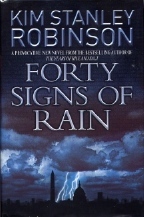
With 'Sixty Days and Counting' Kim Stanley Robinson tops off his Science in the Capital trilogy in fine form, deftly combining domestic comedy with scientific veracity. It's not a common combination, but Robinson shows a real talent for dialing back and forth between global dilemmas and household predicaments. I have a full-length, in-depth review posted here. I've tried to review not just the single novel but the series as a whole, because it's more of what Robinson called a "triptych novel" than a series. It's also proving to be increasingly prescient, as the debate about global warming shifts in tone.
Of course, it's works like Robinson's Science in the Capital trilogy and, I would argue, Michael Crichton's 'State of Fear' that helped move the argument about. Crichton's work was not good fiction, and his contrarian arguments against global warming were actually the highlight of the book. But by bringing up the subject in a global literary marketplace, he did raise awareness, mostly of the arguments against his contrarian views. Robinson's work was a perfect example of science fiction predicting the present. By the time 'Forty Signs of Rain' and 'Fifty Degrees Below' had made the journey from Robinson's mind to the printed page, much of what he posited came to pass. While we're nearly two years away from another presidential election, we can expect that the next occupant of the White House will have to deal with our inaction thus far, just as does Phil Chase in this sequel. Of course, Chase is a reasonable, pretty much down-to-earth politician. This is probably the most "science fiction" element of the series.
If you've not started the Science in the Capital series yet, now is a good time to start. It's done, and you can scream from the recent past to the near future in a matter of days. And while the real world hurtles towards hell in an express car, you can watch the fiction world take a parallel slide. If you’re lucky you can invest your life with the same quirky charm you'll find in the lives of Robinson's characters. Though I must admit that none of my friends or co-workers lives in a tree house. So far as I know, at least.
02-15-07: Jay Lake Turns the 'Mainspring' ; A Review of 'Mathematicians in Love' By Rudy Rucker
A Clockwork Universe
I grew up for a large part of my life in Los Angeles, and some of my favorite memories are of going to the various observatories there. I spent many a day at Griffith Observatory and a few evenings at a smaller planetarium / observatory in Pomona. I loved all the star charts and solar system mock-ups, called orreries, those intricate clockwork models. Back then, I thought of them as science. Funny how that works; now they've become art. I must say I think they're gorgeous.
Jay Lake's new novel, 'Mainspring' (Tor / Tom Doherty Associates ; June 12, 2007 ; $24.95) posits a universe that is indeed clockwork. The planets move on visible gears around the sun. The structure of the universe is there for all to see. The handiwork of the creator is laid bare and any questions may be answered if you just look around. Hethor Jacques is a clockmaker's apprentice, just trying to get a good night's sleep when he gets a visit from the Archangel Gabriel, charging him with the duty of taking the Key Perilous and rewinding the Mainspring of the Earth, lest bad things happen. A novel to die for.
I was fortunate to be on the periphery as Lake brought the novel into being, and he was kind enough to fill in the blanks from what I saw. And so reader, here's you first glimpse into the clockwork behind 'Mainspring', which I suspect is going to be one of the big novels of this spring and early summer.
RK: Could you talk about the origins of the idea for Mainspring?
JL: MAINSPRING actually very first began as an exercise at a writing retreat, when I was being challenged to write viable novel proposals. I'd done a little research before on Medieval orreries and have long been fascinated by clockwork in general. Both in terms of time keeping and in terms of mechanical artifice, clockwork is one of the great arts of our civilization. Read up on the Schwilgué Clock, for example.
Once I started thinking seriously about the idea, I took it to the Fortean Times email list. That's as assorted a bunch of rugged intellectual individualists and iconoclasts as you'd care to find. There was quite a bit of discussion about the core concept -- the Earth orbiting the sun on a brass track -- and a gentleman in England, an aerospace engineer by the name of Robin Hill actually designed the appropriate gearing for me to account for axial tilt, the moon's orbit, etc. In the final analysis, I went with a simpler, more visually driven solution, though his work was very important in helping me realize the idea.
RK: Could you talk about the religious implications of the world you create?

The Schwilgué Clock in Strasborg from Wikipedia.
JL: Heh. It's almost the opposite of my personal worldview. This is a Young Earth, using Bishop Ussher's timeline. The handiwork of God the Creator is undeniable as the gears of Heaven hang glowing in the evening sky. There are no atheists, only dissenters.
At the same time, God has been absent since Creation. Think of the concept of God-the-watchmaker, from Enlightenment philosophy. That's pretty much the theological concept here. Angels still watch over the Earth, and there is a Christ, executed not on the cross but the horofix, or Roman wheel-and-gear.
The relationship of man to God is therefore very different, and the way people approach their place in the world likewise. To me, this is another way of looking at individual responsibility, conformity and the lack thereof -- all issues I deal with regularly in my fiction.
RK: Could you comment on the world-building aspects of this novel?
JL: Can I take the fifth on this one? Science Fictionally speaking, it makes no sense at all. I mean, think for a minute about a ring of brass 90 million miles in radius sitting in Earth's orbit. Thermal expansion, brittleness, the gravitational effects. Writing like this means playing it deadpan straight while hoping like heck no one pays attention to the man behind the curtain.
Inside the world, I closely adapted recent history. It's set in 1900, Lloyd George is prime minister of England, the British Empire rules everything from St. Louis to Calcutta, including all of Continental Europe. It is primarily opposed by the Equatorial Wall -- the 100 mile high ring at the waist of the world atop which the gears are found -- and by the Chinese Empire. Again, in a world with only the Northern Hemisphere, why would Victoria have ruled? This isn't Alternate History, not by a long shot. But I play it straight, use familiar elements to contrast the high weirdness, and hopefully the reader has a lot of fun.
RK: Will there be a sequel?
JL: Indeed. It has the working title of STEMWINDER, and I'm about to turn the initial submission draft into Tor by the end of February.
When I wrote Robin Hill of the Fortean list to ask if I could use his name, he gave me some very interesting additional information:
"I remember it did get monstrously complicated. We had a pretty deep discussion on how it was all supposed to work, the problems of heating and cooling such a huge structure, how to take account of age and general wear-and-tear. I must admit that the idea of a steam-powered solar system fabricated of brass and ivory does somewhat appeal, especially if it explains the occasional earthquakes caused by gears running near to the planetary gimbals. Modern science fiction simply doesn't have enough brass in it any more..."
I certainly could not agree more! And with that, readers, are veritable herds of pre-orders made. If I could pre-order 'Stemwinder' I would do so. But the clockwork of the publishing world, equally visible moves so slowly. One second, minute, one day at a time. If only I could see the gears. If only I could make them move.
The Best of All Possible Worlds
In the best of all possible worlds, Rudy Rucker would be a bestselling author. His goofy, funny, sweet and weird novel 'Mathematicians in Love' has something for everyone, with the exception of those who refuse to read novels that include flying, talking squids. It's certainly his most accessible novel that I've read. I try to capture what made the novel work so well for me in my in-depth review. As with many of my reviews, I suspect some people will say that I really like the book and that they would as well, while the anti-flying/talking squid contingent would, of course, beg to differ. I'm thinking that's a fairly insignificant and actually shrinking part of our population.
'Mathematicians in Love' is an excellent example of the genre that Rucker calls Transrealism, which he talked about in our interview. He writes in the first person about a scene he knows very well, that of grad student mathematicians. He's been one and taught them as well. As he injects an increasing proportion of out-and-out weirdness into what begins as a fairly normal narrative (other than the "it's not our reality" aspect) readers will feel their own world transformed. This is psychedelic literature for children of Timothy Leary's legacy. It's smart, surreal and well worth your valuable time, even if you can't edit the universe to give yourself more time. And damn, with all the fine books in Rucker's back catalogue, I'd really like to have a lot more time. Where's my universe-altering membrane?
02-14-07: A Review of 'No Dominion' by Charlie Huston ; David Drake Lights 'Balefires'
Love is in the Air
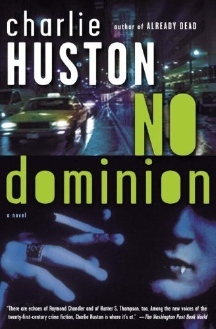
I'm not really loving this cover design. Well, sort of. I mean, Joe Pitt, the blood-drinking, hard-boiled detective of 'No Dominion' by Charlie Huston has a love interest and it's a serious part of the novel that actually provides a nice contrast to the scathing, over-the-top violence that characterizes the rest of the narrative. So here's my valentine to readers; my third count (Dracula) it, third review this week. With a new book article to boot. And still I'm far behind in the flood of worth reading.
Be that as it may, there are some important things to say about 'No Dominion', with regards as to how it measures up as a novel in a series that, according to Huston in the interview we did recently, will span five books. And as with any Charlie Huston novel, there's the very important "fuck" quotient. This refers not the amount of sex, but the number of times the word "fuck" itself is used and how well it is deployed. One also wishes to know whether Huston manages to top himself (not in the sense of suicide) in terms of violence, when compared to both 'Already Dead' and the Hank Thompson books like 'Caught Stealing'. I think readers who will look for more shall find it, and those who hope for less will be tossed into a meat grinder and turned into food. In other words, this is the sort of novel where more is more.
In my review, I've focused on the series aspects and left the plot for you to discover. Huston is pretty twisty, but to my mind at least, plot's not the point in 'No Dominion'. The point is that Huston tries and succeeds in his effort to drive a stake through the heart of wussy vampires. See what I mean. Love is in the air! In a fine red mist of blood.
Tales of the Weird and Fantastic
Lots of folks probably know David Drake for his hard-spec, mil-SF. The Hammer's Slammers stories and novels occupy a prime position in the world of mil-SF and for good reason. They're gritty and well-written explorations of the future conflicts that resonate in the present. Given that we Americans in particular and humans in general seem to be really interested in blowing one another up, this sort of has a compelling import beyond the thrill of reading Gripping Future Adventure Stories.
Then there are Drake's fantasy fans, who enjoy his Ranks of Bronze or Lord of the Isles stories for much the same reason if you substitute "Medieval" for "Future". The same virtues mark both series. What really helps Drake's fiction is a generous sense of humor about himself and his work that keeps the various serious goings-on a goodly distance from the bathetic or pompous.
Both sets of fans can be thankful that it was Night Shade Books who snagged Drake, and 'Balefires' (Night Shade Books ; May 15, 2007 ; $26.95) has something to offer not only Drake's substantial fanbase, but others outside of his normal range. 'Balefires' focuses on Drake's early short stories of horror and fantasy. As one might expect, they offer many of the pleasures of his SF. They're direct, darkly humorous and sport a take-no-prisoners mentality.
Variety is the watchword here and there's plenty of it. "The Red Leer" spins off from Theodore Sturgeon's iconic 'Killdozer'. I remember reading that story when I was a kid and being highly impressed. It was one of the stories that got me where I am today. Unlike Sturgeon's tale, Drake's story involves a monster we get to see and I like seeing monsters. "A Land of Romance" is the very peculiar tale of a Fast Food King with a penchant for serving exotic meats. This is rarely a good sign. "Blood Debt" delves into witchcraft in a modern setting. "The Elf House" is a story from the Lord of Isles universe, while "Arclight", his first sale to an SF magazine, trades more on his mil-SF.
As with many good collections, one of the pleasures of 'Balefires' are the story notes by Drake. They are longish, chatty and highly entertaining vignettes that offer glimpses of not just Drake and his personal writing process but his years of experience in the business, meeting with many of the greatest editors and writers the genre has to offer. There's a significant non-fiction content here, a sort of meet-the-author feel that you might get if you attended say 24 book signings. Don't do that. It's creepy, and if you do, Drake is liable to write a story about you that's unlikely to be flattering.
With twenty-four stories, 'Balefires' covers an impressive range and gives readers who might not have heretofore have been interested in Drake because of his genre specializations in mil-SF and fantasy a reason to pick his work up, and his fans a new look at their favorite author. The mainstream, New York publishers seem to be unwilling to publish single-author collections, but folks like Night Shade are cleaning up as a result. 'Balefires' is an excellent reason why. It offers great stories by an established author working outside his normal realm. You may think you know David Drake. Just don’t let him drive a bulldozer. 'Balefires' will keep the midnight light burning.
02-13-07: 'The Annotated Cat : Under the Hats of Seuss and His Cats' by Doctor Seuss, Annotated by Philip Nel; A Review of 'Eragon' Christopher Paolini
Why Johnny Reads
And we wonder. Here in the 21st century, the children of Doctor Seuss presume to judge. Back in 1957 however, things were not so simple. In the introduction to 'The Annotated Cat : Under the Hats of Seuss and His Cats' (Random House ; January 9, 2007 ; $30), annotator Philip Nel writes: "It was 1954 and many Americans were worried: why can't Johnny read? In a Life Magazine article, John Hersey said that Johnny and Susie were not learning to read because the Dick and Jane primers were boring. Hersey proposed that Doctor Seuss write a reading primer to replace Dick and Jane."
And thus is a classic born. Like many readers of my generation, I cut my teeth on Seuss and still have the volumes my parents bought me so long ago. I'll make no bones about it. When this book arrived in the mail, all I wanted to do was sit down and flip through it. I enjoyed the original book, embedded in 188 pages of DVD-style special features. I enjoyed the special features. And I especially enjoyed the fact that it arrived as I struggled to write a review of 'Eragon', kiddie-lit 21st century style.
'The Annotated Cat' literally annotates every single line of both 'The Cat in the Hat' and 'The Cat in the Hat Comes Back'. It's a treasury of Seuss trivia, the kind of coffee-table book that will get used. This volume will be perused and commented upon by anyone who comes within range of its peculiar gravity. Because yes, there is a peculiar gravity here. Not that we don’t all know the import of the book, or the changes that followed its release. But the annotated version lets us enjoy it again and again by placing it in context, by offering up boatloads of background that at times seem as silly as the original material. And that's perfectly OK.
But make no mistake about it, 'The Cat in the Hat' and 'The Cat in the Hat Comes Back' are fantasy and Nel's analysis gets at the heart of early-reader fantasy literature. The influences of Sendak, Rube Goldberg, and Seuss's advertising career pop up as often as fish fly from the fishbowl. There's a good year's worth of dipping and browsing here, and the absurdity of a lengthy analysis of, "so I ran in after" (page 108) is certainly not accidental. While this is not the ideal format to read the original books, it is the ideal framework within which to experience their cultural impact.
The production values here are outstanding. The colors are vibrant and crisp. The layout is easily grasped. There are lots of supplemental illustrations here that will be a big draw for those of us who read Seuss as we first learned to read. Posters by Seuss exploit the absurdity of the English language, and word-juggling gets explained. Draft illustrations compel you to open the book.
We begin to read. We all begin somewhere. Returning to our beginnings and examining them as adults is a perhaps perverse pleasure. But we'll take our pleasures where we can find them. 'The Annotated Cat : Under the Hats of Seuss and His Cats' is a place where a lot of readers will be able to find pleasure.
Familiarly Dismissed
What catches our fancy is impossible to predict. Which is why, in a world that had been cluttered with Lord of the Rings rip-offs for more than 30 years, 'Eragon' by Christopher Paolini finally took flight. One might be tempted to say that it followed in the footsteps of JK Rowling's Harry Potter novels, but the two are quite different. The Rowling novels offer an original milieu of the fantastic (magic) and the mundane (school). 'Eragon' is the three millionth version of 'The Hobbit' with each fantasy cliché carefully visited and tagged with an almost obsessive attention. Paolini even manages a number of nods to Star Wars in his no-spaceships fantasy.
But while 'Eragon' lacks invention, it certainly does not lack either energy or popularity. The former makes it easy to read; the latter may mean that your child will be reading it. In the event this happens and you find yourself being asked to read the book by the very same offspring who would rather go to school than read a book, rest assured that it's just a beginning and not a bad one. We don’t often get opportunities to revisit or relive our childhood reading. Cherish them.
02-12-07 : A 2007 Interview With Cory Doctorow; UPDATE: Days of Present Passed
The Book Is 'Overclocked', The Man Is Overbooked

Cory Doctorow at Borderlands Books. Cory's Book at home.
At least that was my joke to myself going into this fascinating interview. But let's ratchet back a bit. If this is the first time you’re seeing 'Overclocked' (Thunder's Mouth Press / Avalon ; January 11, 2007; $15.95), the new collection by Cory Doctorow, you're not reading boingboing.net, the Mother of All Blogs that he contributes to regularly.
Fix that. Boingboing is must-read Internet writing. 'Overclocked' is a must-read trade paperback for paper fetishists – and I trust that you're a paper fetishist if you're reading this column. If you want a taste of the book, you can download the whole shebang from Cory's website here. Cory won’t mind. He told me in his interview.
Getting the interview set up was a bit of an adventure, but in the end, it worked out spectacularly well. We met at Borderlands Books, the specialist SF shop in San Francisco.
While Santa Cruz has some spectacular bookstores, they don’t have any SF specialist shops. It was such a pleasure to browse at Borderlands, even if I couldn’t afford to spend the $1000-plus I racked up in potential purchases. Alan Beatts, the owner of Borderlands was exceedingly kind, offering us a capacious back room in which to speak, and we did, for a solid hour, until Cory's fans began to arrive for this signing at the store. Buy signed copies of the book from them.
And while you wait for the book to arrive, you can enjoy this interview. I had Cory read the entire first story from the collection, 'Printcrime', and then we talked about ubiquitous technology, DRM software, the RIAA and the MPAA, his two forthcoming novels, and much, much more. I've got a DRM-free MP3 for you. We got such great sound in that room that I'm offering my usual hi-fi version. And as well, the RealAudio version (with the "copy protect" checkbox disabled) for those who prefer it. But trust me on this. Cory is Worth Your Valuable Time and Bandwidth. Enjoy!
A Review of 'Overclocked'
I've just completed a review of Cory's new collection, 'Overclocked'. It means "caffeinated", overbooked, too much right now, too much later and toomuch yesterday as well. Cory informs us that the first printing has sold out so what;s on the shelves is the first printing. better buy it fast and if that itself if not a perfect review of this excellent tome, then let me offer up mine. Even if you've read them beforek, weven if you've read them online, here is a tech-proof, single-source method for carrying them around, loaning them to others. Here's a way to spread the word. And that in itself is all a column like this one can hope to achieve. I suggest you buy 'Overclocked'. You might even have time to read it in this handy format.
